Last updated on September 28, 2023
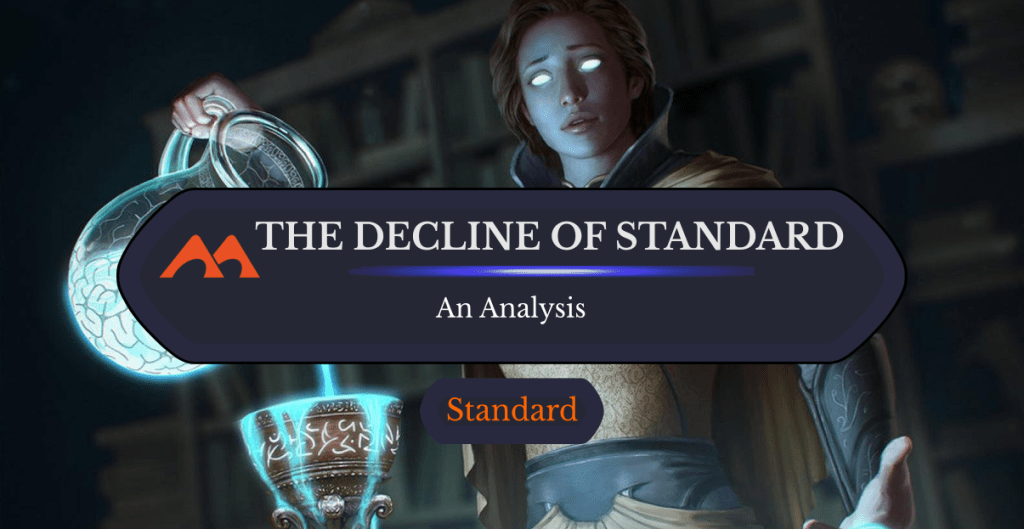
Diminishing Returns | Illustration by Greg Opalinski
It’s no secret that in-store Standard has been on the decline over the past few years. Magic has a continued emphasis on digital play, releasing digital-exclusive products and formats alongside their onslaught of paper releases each year.
There are tons of possible reasons and theories behind the format’s decline. Some focus on an increasingly costly barrier to entry while others point fingers at set velocity, and others still blame timing factors.
After the recent online discourse following a tweet by Aaron Forsythe, the vice president of design at Magic, I thought it might be interesting to dive into the data—at least, what’s available—and try and see just what might be causing the decline of this once-popular format. Come with me to see just what factors are to blame and which theories don’t hold up!
The PT Dream Is Dead (So Are GPs)

Defiler of Dreams (Dominaria United) | Illustration by Ryan Pancoast
Between the notion that Standard doesn’t receive the same set-specific treatment that Modern gets and the raw cost of decks being a barrier to entry, there’s room for more nuanced reasons behind its decline.
Players can’t realistically use a lot of their expensive Standard cards in other formats because their power level fades compared to many cards from supplemental sets. There needs to be another incentive to get players to buy Standard-legal cards.
The Pro Tour and Pro Tour Qualifiers (PTQ) were that exact incentive before 2018. Standard was the most common format at the Pro Tour, and that resulted in just about every game store hosting a Preliminary PTQ (PPTQ) a few times a year. It gave players a chance to get through the first round of trials and reach their dream of playing professionally.
On top of using their Standard cards in other formats (which helps to keep their value after rotation), players had a huge incentive to get into Standard beyond having some of the cards from Limited play. As pro player Andrea Mengucci mentioned, players no longer have a reason to play. Players “had” to play certain formats before because they were the ones played at Pro Tours, GPs, and PTQs.
Standard was played competitively everywhere on paper, and it had a lot of events. There were championships at every level, but Standard was also a common format for a Grand Prix, a regional convention/tournament (perhaps with sub-tournaments), side events, and other fun venues in a large city. While the new RCQ and Regional Championships do their best to fill these shoes, they aren’t a perfect fit (more on this later).
Players could try to win the event for a large prize and Pro Tour invitation, or play a few one-day tournaments or events. It was another thing to do with your Standard deck. While the Pro Tour is back, there is a lot of structural inertia involved with rebuilding after the previous system, plus different player behavior and habits due to the pandemic.
People were also watching players face off in Standard all the time. Pro Tours, Worlds, and various tournaments by organizations like Star City Games or Channel Fireball were broadcast to tens of thousands of people just about every weekend.
What About Regional Champions and Qualifiers?
Regional Champions and the suite of RCQs, alongside the return of the Pro Tour, were something that completely changed the trajectory of competitive Magic play in 2022. At least it’s a start to reviving that “Pro Tour Dream” that incentivized so many players.
But these new tournaments and overall structure do little to help Standard as a format. Most RCQs are either Modern or Pioneer, and the most recent Regional Championship was also Pioneer. There have been no incentives or requirements for Standard play; all the recent gameplay have been either Pioneer or Modern. Only now is Standard taking a turn at the next Regional Championship in San Diego.
I reached out to Saffron Olive of MTGGoldfish to ask what he thought about the decline of Standard, specifically with the return of the Pro Tour and introduction of Regional Championships. He was happy to see it and remains hopeful, but he has limited expectations about Wizards’ intentions.
“I think they are hoping the new RCQ/RC system helps bring competitive paper players back into the game,“ he said before stating that he was “unsure” it will be enough. He also mentioned the Grand Prix system, saying that it was something Wizards will “build off of in future years, adding more qualifiers and maybe something similar to Grand Prix.”
I think Saffron Olive makes the most important point here. The new Pro Tour and competitive structure have similarities to the previous system. It’s infinitely better than nothing, but it doesn’t do the same for Standard that its ancestor once did.
What LGS Owners Are Saying
I talked briefly with Lance Shrader, owner of Gamers Geekery & Tavern, an LGS I used to go to when I lived in the area. The store, previously known as East Coast Gaming, has radically transitioned over the last few years from a Magic-centric game store to focusing more on general board games and a tavern-like environment.
They’ve started selling alcohol, have a full food menu, and a wall of board games available to play for free. None of this existed when it was mostly focused on Magic, and its transformation makes it a great place to see the impact Magic’s changes have had. Standard was the highlight of Magic gameplay at GGT not too long ago, but Lance saw the writing on the wall.
Standard drew the most players to the store right after we opened in 2014. To me the format was on the decline even then. The format changes so fast that it was really only a draw for players with a lot of time.
Lance Shrader, GGT
Standard isn’t even offered as an event type at GGT in 2022. The store caters toward casual play and other games, so Commander absolutely dominates the tables between the occasional Modern or Legacy tournament. Lance went on to say that even FNM was faltering in favor of the Monday Commander Nights they offer for free.
Obviously we no longer have Standard format events as they are not a draw. The largest impact I have seen is the decline of Constructed events at FNM. Most weeks we only have draft tables at this point.
Lance Shrader, GGT
Lance lastly mentioned the rollercoaster that Magic can be for local stores, especially during tumultuous times or shifting Constructed formats:
One of the reasons we are on the model we have is so that we are not as Magic dependent as other stores. Whenever we cannot have Magic events we just try and have other events. From Meetup groups to corporate parties we have done a pretty good job of isolated ourselves from the ups and downs of competitive Magic.
Lance Shrader, GGT
Set Releases and Velocity
I see lots of players blaming things like set velocity (the number and frequency of set releases) in response to a thread by Aaron Forsythe on Standard play “drying up.”
This is a pretty easy claim to verify, so I did exactly that. I started by compiling all the expansion sets that were/would’ve been Standard legal (remember, Standard was created in January of 1995), including Core sets, and deemed those “regular sets.” I then added in their release year and plotted it over time:
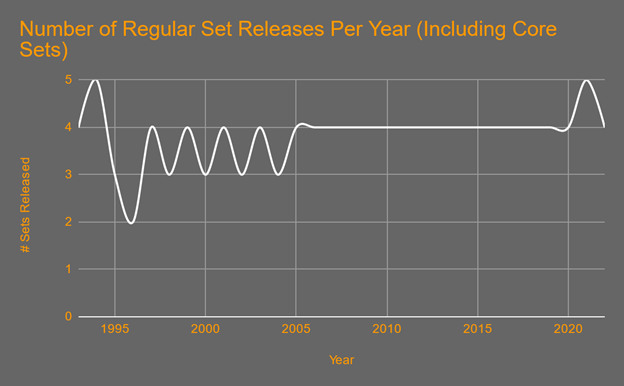

As shown, the average number of regular sets released each year hasn’t really changed. There was a spike in 2021 with five sets but I don’t think it’s reasonable to say that those extra sets had a sizeable impact on the format one way or another.
When controlling for Core sets, it’s apparent how Magic stabilized Standard between 2005 and 2020. There were consistently four sets releases, about one each quarter, and that added some regularity and consistency to releases.
Taking the number of days between each set to create an average for each respective year helps evaluate velocity:
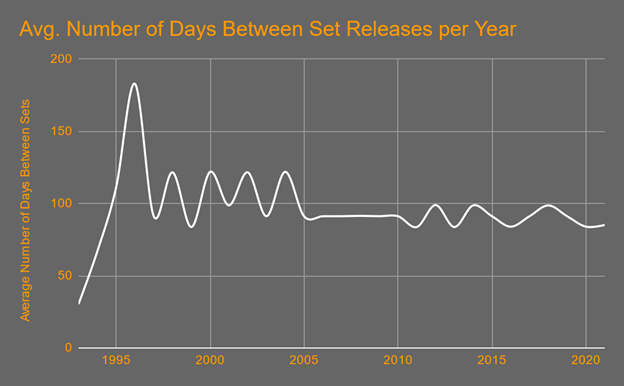
The average time between these regular set releases hasn’t changed much, and it certainly hasn’t increased so drastically that players can’t keep up with the format. On average the time between these sets was 121 days year after year. This average is only brought down to 91 with the additional handful of sets in 2021 and 2022.
It’s safe to say that Standard’s overall decline isn’t a result of the sheer number of Standard-legal set releases or how closely released they are to one another.
Supplemental Sets and Their Impact
Supplemental sets are a relatively new type of product Wizards has started to release year after year. They've already made a significant impact on the metagame of a lot of formats and the formats people choose to play.
There are sets like Modern Horizons and Modern Horizons 2, but sets like Commander Legends and Conspiracy are also supplemental. These are never Standard legal and they’re usually reserved for format-specific sets that don’t contain reprints, or sets intended to create a format itself (like Conspiracy).
These types of sets didn’t exist before 2010 but they keep coming, and in larger numbers:
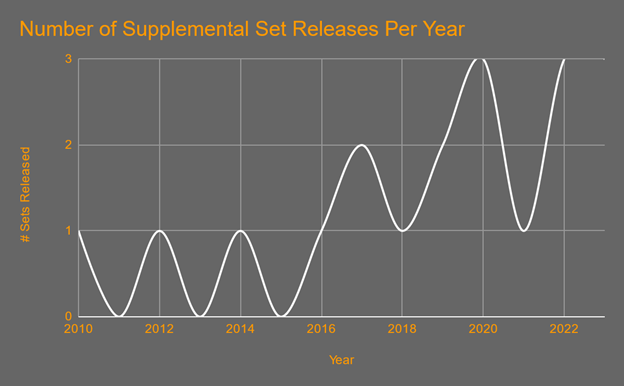
When you compare this data to the timeline of regular releases, you see that this hasn’t had any impact on them whatsoever. Magic is releasing more products, period. They’re not prioritizing or neglecting any one type of product in particular.
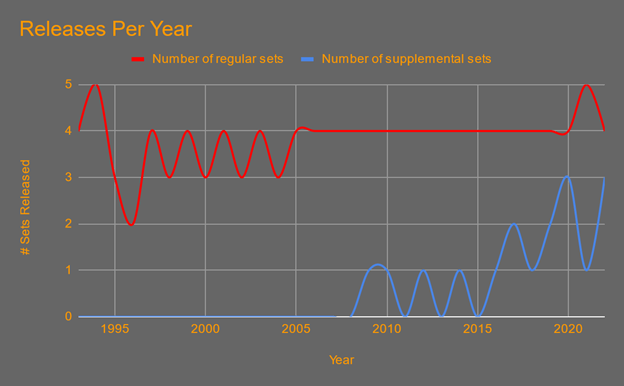
But there may be an impact that isn’t reflected in this data. Just because the increasing number of supplemental sets isn’t correlated with fewer regular sets doesn’t mean that players are buying both.
There isn’t a vast database from Wizards showing the percentage of cards come from each set in each format over time, but you can make a guess from MTGGoldfish’s data compiled from MTGO leagues and challenges:
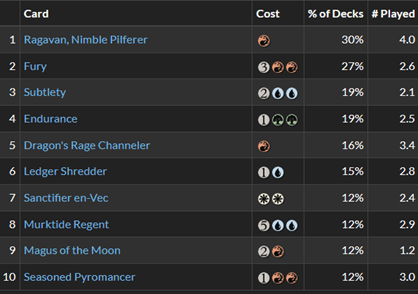
Looking at Modern’s top creatures as of November 20, 2022, creatures from supplemental sets make up eight of the 10 top inclusions, with Ragavan, Nimble Pilferer being played as a 4-of in 30% of decks. A handful of cards are included in many decks in the format, but almost all of the most popular creatures are from Modern Horizons 2!

Compare that to the data from October 2017 and you get a very different story. Modern-specific supplemental sets didn’t exist, so there’s a larger spread of dominance for these cards.
How Does Price Function as a Barrier to Entry?
I saw a lot of players mentioning the high price of Standard as a reason for its overall decline. But Standard has always been pretty expensive. Top decks frequently reached into the $400 to $500 range. That’s nothing new.
But the actual use of Standard-legal cards, which drove up the price so much, has drastically decreased. Before supplemental sets players could get incredible value out of cards in regular sets. You could draft and play Sealed on release to pick up some commons and uncommons. You might even snag a few staple rares or mythics. You could then use this small collection as a starting point to the format and would only need to buy the singles you didn’t already have to assemble a complete deck.
Remember, this is about the decline of Standard, not Limited. Players still draft and play Sealed at pre-release all the time, so what changed? The answer is what players can do with their Standard cards once they rotate.

Looking at that same table of cards being played in Modern from 2017, there are a few cards that were once Standard-legal: Thought-Knot Seer, Reality Smasher, Walking Ballista, and Matter Reshaper. Nearly all these cards were once legal in Standard, but they were also together in a Standard deck.
Somebody who bought into Standard to play Eldrazi eventually had the opportunity to use the best cards from that deck in another deck in Modern. These cards had rigidity against rotation, while nowadays a lot of Standard bombs plummet in price after rotation because they have no place to go.
While supplemental sets haven’t impacted the release of Standard by interrupting the releases, they’ve made the still-expensive Standard cards a less safe investment. Now you have to either sell them before rotation (you’ve got a year) or absorb a loss of potentially hundreds of dollars.
The prices of Standard decks haven’t really gotten higher, but that investment just isn’t worth it in the long run anymore. Players don’t mind buying into expensive formats as long as their investment doesn’t totally implode in two years (cards aren’t turnips and this ain’t Animal Crossing).
Alchemy Failed to Fix Standard
There’s been an emphasis on MTG Arena as a way to play our favorite card game, and it’s also been a testing ground for ideas and formats Wizards hasn’t/can’t fully deploy. One of these is Alchemy, a digital-only format that seeks to get ahead of Standard’s problems by fixing them as they appear.
Standard was limited to whatever a banlist could do, but Alchemy can get around these issues as a digital format. Instead of banning a problem card due to an overpowered combo or a format-defining card, Wizards can just nerf or buff other cards in Alchemy. It’s an interesting solution, and one that other digital card games have already employed.
This doesn’t fix the problem of why players aren’t buying Standard decks anymore. The problem with Standard isn’t that it’s too expensive now compared to previous years or that there are too many problem cards, it’s that the investment in a Standard deck doesn’t have the same longevity it once had.
That problem is only heightened by Alchemy, which is naturally limited to play exclusively on MTG Arena. If you use your precious wildcards to buy a digital Alchemy deck only for that card to be nerfed, you’re done for. There are no refunds for wildcards used on cards that were later nerfed like in other games, Wizards only employs that function for cards that are banned.
In the case of fixing Standard, Alchemy just seems like a purely worse version. Where does that even leave paper Standard if digital formats are the new focus? Are the people playing Alchemy even interested in Standard, or is this audience just people who play Arena as a digital card game and want nothing to do with paper Magic?
Magic Pro League
The Magic Pro League (MPL) was a very short competitive structure that lasted from 2019 until the return of the Pro Tour in 2022. It was the start of Wizards’ massive push to get players to take MTG Arena seriously as a client, and it absolutely had a hand in taking some of Standard’s space as a competitive format.
With the Grand Prix system long gone, the Rivals League was introduced within the MPL to function as the top level of play. It started with a 24-player league in the latter half of 2020, down from the 32 that the MPL began with. More and more online tournaments were held as time went on, with top players going on to the World Finals at the end of 2020 and 2021.
The system wasn’t well received by players. Many thought it was the beginning of the end, and that may have had some credit if Wizards didn’t swap systems in the middle of 2022. With nearly all competition being done on MTG Arena, another system that players had to buy into that left in-store play out to rot, the incentives for players to actually play Standard continued to dwindle.
Players weren’t going into their stores anymore. You can Draft online, all the competition is online, and if you’re buying into an online game, why spend even more money to play in-person when there’s no incentive?
Wrap Up

Finale of Devastation | Illustration by Bayard Wu
Standard’s in-store decline is the culmination of a variety of factors, not just any one bad decision by WotC. Players just don’t have the same incentive to go into the store anymore, especially when the value of opening Standard-legal packs isn’t there.
Players have always been fine with paying larger sums to play different formats, but in-store Standard just doesn’t have the same kind of longevity or security as an investment that it once had. As more and more supplemental sets overrun Standard cards in eternal formats, the likelihood of the average player buying rotating cards that they can’t use anywhere post-rotation continues to decline.
That said, we can still root out certain reasons like increased velocity or fewer set releases. It also wouldn’t make sense to say that the return of competitive play on-paper has done much to revive the format. The RCQ and RC system has a long way to go in filling those large PT and GP shoes, but it’s certainly an improvement.
What do you think is the main reason Standard is on the decline? Do you still play it? Where? Let me know your thoughts, opinions, and how you currently play the game in the comments below or come talk about it in the Draftsim Discord.
Until next time, stay safe and stay healthy!
Follow Draftsim for awesome articles and set updates:

6 Comments
Let’s be blunt and call it what it is.
It boils down to WotC’s greed. There are so many ways this plays out, where does one start??? But if you play, you know what I’m talking about. From $1000 proxy packs… to making sure all the staple cards in Standard are rares and mythics to drive sales… to cancelling the pro-tour… to the plethora of crappy products… to cancelling the pro-tour. It’s all about short term gains at the expense of the long term health of the game and the community.
From the view If s TO of an mid sized LGS: Standard was a the Gateway for nee players in 1v1 Magic at Store Events.
GP was Not interessting for most players and Standarddecks we’re always expensive.
Commander is healthy, people still buy cards.
But now over 50% of those cards aren’t standard legal any more. 5 years ago, a Casual Player who started a year ago, all of His cards we’re Standard Legal. With some Trades he could build a Deck and visit FNM. With COVID this had dryed Up completly. Without Standard there are to few Players migrating to Pioneer and Modern. 1v1 Magic will decrease of that and Not because of Missing GPs (this was only interessting for a fraction of the Player Base).
Seems to me it has to do with the advent of netdecking. Standard became, “play these 3 decks or lose”. Only a select few care that much to buy $200 worth of cards each set to play someone else’s deck.
I don’t play edh…but Edh solves that by expanding the amount of decks you play and interesting cards to use and also allowing decks to be competitive.
Standard is just boring.
It’s a lot of things but it’s not because of netdecking. That has been around since about 1996.
I agree 100% with this. I am 45 and play from beta to Homelands. When I got back into the diversity was over. It was okay these deck or don’t win. No one wants to admit it but the card sets come out to fast, cards are to strong. Why would you pay any money at all to join a tournament to get melted by the same 3 deck? No originality comes from it. Back in the 90s you could go to a tournament and see several different deck. Anyone could play and had a chance. I play commander or pauper now, it’s more balanced. The game is diluted. The dude above is correct and this author is wrong.
As a shop owner, arena was a big part of what killed it. Offering standard play online two weeks before caused players to be “played out” by the time I received paper product.
And anyone who says the amount of product released isn’t related is crazy. I saw it every day. Players only have so much money to spend on magic. When you keep ramming sets down the throats of an LGS, we feel it. We can’t sell as much of any product because we need to buy a wider spread. No longer one booster box but two! Remastered sets. Masters sets. Modern sets. Commander sets.
My players loved the game and wanted to see the cards each set, but reached a point where they couldn’t.
Add in the complete BS of secret lairs, which was a direct slap in the face to every LGS.
Magic is teetering. And it is 100% the fault of WOTC and Hasbro. Overprinting and overproducing. And being confused…..
Add Comment